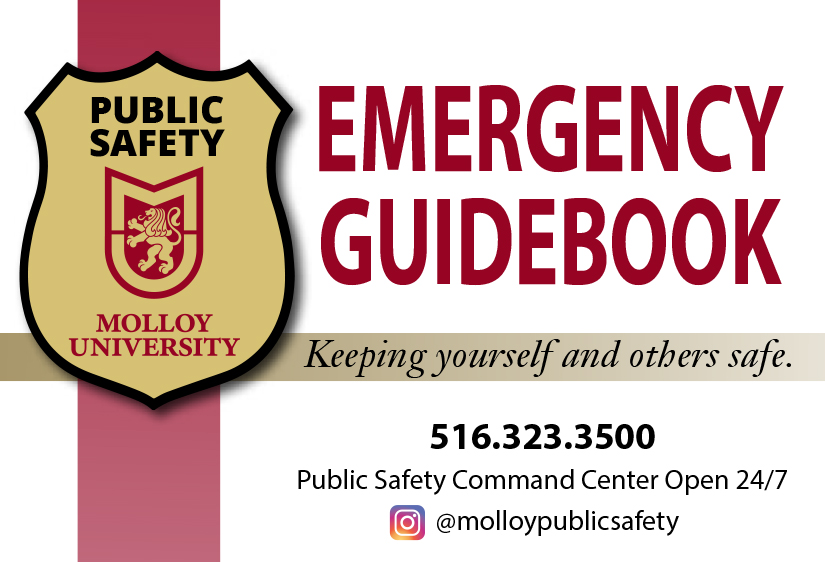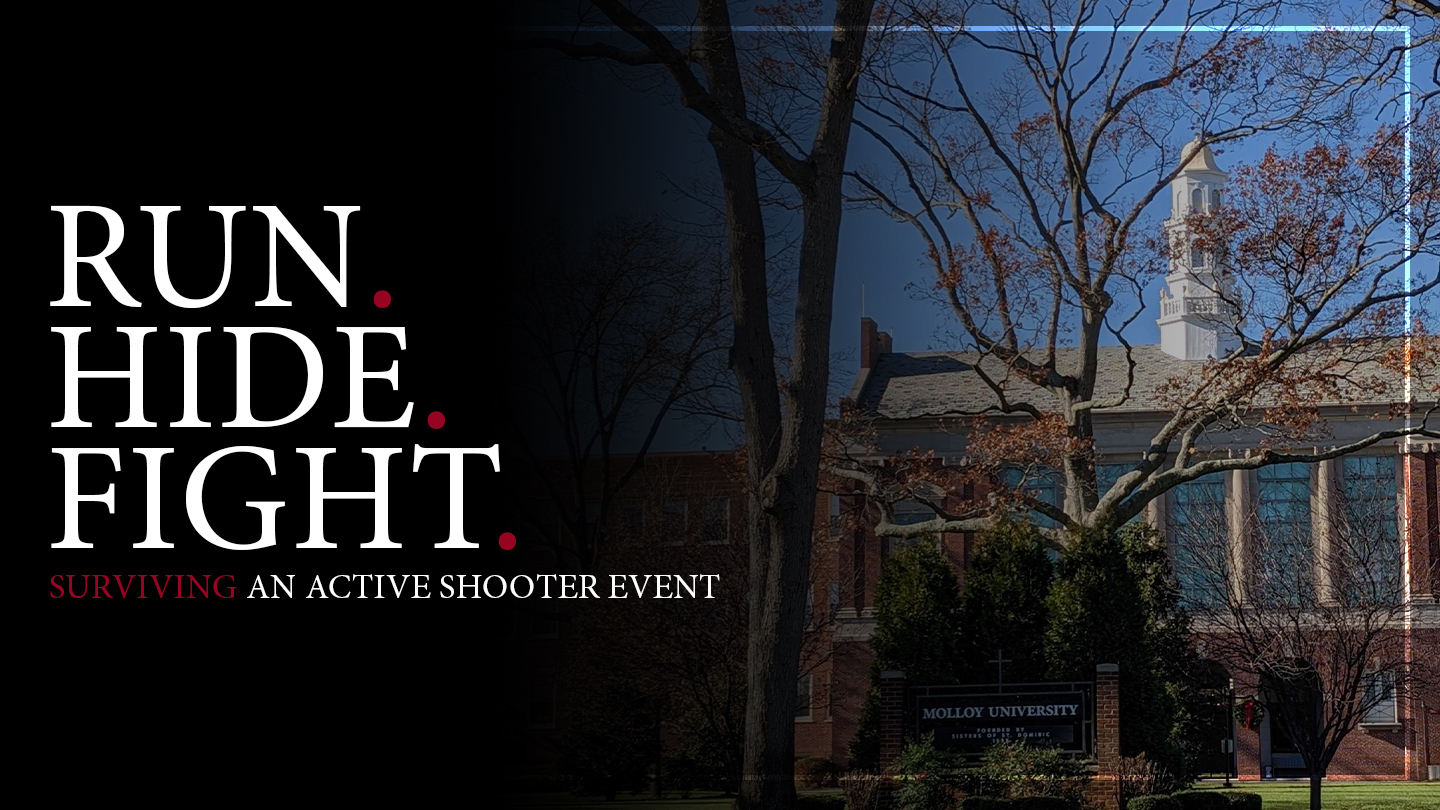Emergency Action Plans

Cardiac Emergency Response Plan (CERP)
Sudden Cardiac Arrest (SCA) is a leading cause of death in the United States. Sudden cardiac arrest events can vary greatly, but all are emergencies that require immediate action. In an effort to achieve optimal outcomes for victims, Cardiac Emergency Response Protocols (CERP) provide systematic evidenced based guidelines on how to respond to potential episodes of cardiac arrest occurring in the community.
Signs of SCA can be presented by the victim as one or more of the following:
- Not moving, unresponsive or unconscious, or
- Not breathing normally (i.e., may have irregular breathing, gasping or gurgling or no breathing), or
- Seizure or convulsion-like activity, or
- Eyes rolling back.
-
Development of the Cardiac Emergency Response Plan (CERP)
The Cardiac Emergency Response Plan (Appendix 1, Appendix 2) was developed by the Molloy University Heart Safe Committee. The committee is comprised of nursing faculty and members of the Molloy Student Nurse Association. The members maintain current Basic Life Support (BLS) training, which includes use of the AED.
-
Cardiac Emergency Response Plan Steps
(Refer to infographic in Appendices 1 & 2 in the Cardiac Emergency Response Plan PDF)
- Is someone in cardiac arrest?
- Make sure the scene is safe.
If yes to # 1 go to step 3 (If uncertain; call Public Safety 516-323-3500) - Call 9-1-1 (or direct someone to call 9-1-1).
- Get an Automated External Defibrillator (AED) (or direct someone to get an AED; located in every building on main campus)
- Perform CPR (push hard and fast in the center of the chest 100-120 times per minute)
- Call Public Safety 516-323-3500 (or direct someone to call)
If outdoors on campus and no access to mobile phone, push emergency blue light to call Public Safety
-
2. Communication of the CERP throughout Molloy University campuses
The CERP will be presented:
- At the beginning of each academic year during Community Day
- During orientation programs to new students, staff, faculty, and administrators
- At Freshman Studies (FST) classes when students are educated on Hands-Only CPR
The CERP will be posted:
- Next to each AED box and attached to the AED cabinet
- On the Molloy University website
- In the gym and in all other indoor locations where athletic activities take place.
-
3. Training in CPR and AED use
- The Molloy University Continuing Education office will continue to offer American Heart Association (AHA) Basic Life Support (BLS) courses throughout the year to students, staff, faculty, and the community.
- Hands-Only CPR/AED Training will be provided by members of the Heart Safe committee (faculty and students)
- Freshman students will receive Hands-Only CPR/AED training during FST 1000.
- Staff and Faculty are encouraged to contact the Heart Safe Committee to arrange a Hands-Only CPR/AED training program for their department.
- Pop-Up CPR/AED demonstrations will be conducted on campus by the Heart Safe Committee.
- Required Training in BLS and AED use:
- Public Safety Officers
- Athletic department (Athletic Trainers and coaching staff)
- Health Service RNs and NP
- Faculty in the Health Sciences departments which remain clinically active.
-
4. Activation of CERP
- Once a cardiac emergency is identified anywhere on campus (Rockville Centre, 30 Hempstead, 50 Broadway, CERCOM and Suffolk Center) the appropriate CERP can be implemented by any individual.
- Encourage documentation of sudden cardiac arrest response on Sudden Cardiac Arrest Emergency sheet (Appendix 8).
-
5. Automated External Defibrillators (AEDs) – number, placement and maintenance
- The number of AEDs shall be sufficient to enable a person to retrieve an AED and deliver it to any location within university buildings and/or campus grounds, within three (3) minutes of the identified cardiac emergency.
- AEDs in campus buildings will be stored in unlocked wall boxes that are clearly marked with three dimensional signs visible from the hallways.
- AEDs in campus buildings will be placed at a height no greater than 48 inches in compliance with ADA guidelines.
- Public Safety will maintain one (1) AED in mobile unit on main campus and a back-up AED for replacement of any AED that is out of service.
- Public Safety will designate a site coordinator to be responsible for assessing availability and maintenance of AEDs located in university buildings (Appendix 3, Appendix 4, Appendix 5, Appendix 6).
- AEDs in building locations will be visually inspected each month:
- To ensure the AED is present and the door alarm sounds.
- Defibrillation pads are present and up to date in the case.
- The Pulse Point AED APP will be utilized to monitor expiration dates of battery and defibrillator pads.
- Pulse Point AED is an APP that provides immediate information about all AEDs in the area. The site coordinator receives automatic notification 90 days before expiration of battery and defibrillator pads.
- Items will be replaced as needed and before the expiration date indicated in Pulse Point AED APP. The new expiration date will be updated as necessary.
-
6. CERP Drills
Public Safety and the Heart Safe Committee team shall perform a minimum of two (2) drills each year with the potential participation of students, staff, faculty, and public safety officers (Appendix 7).
- A successful Cardiac Emergency Response Drill is defined as completion of the Drill in five (5) minutes or less, ending with placement of the AED on the victim.
- Public Safety will maintain a Cardiac Emergency Response Drill Report for each drill for five (5) years.
-
7. Review and Evaluation of the CERP
Public Safety and Heart Safe Committee will meet:
- Annually to discuss drill reports
- Within one week of any cardiac emergency that occurred on any of the Molloy University campuses.
- Debriefing with all individuals involved in activation of the CERP will take place (Appendix 8).
Active Shooter & Intruder
If you are on campus and you become aware of an active shooter or hostile intruder situation, how you respond will be dictated by the specific nature of the event. It is imperative that you follow the instructions given to you by the Department of Public Safety, the Rockville Centre Police Department or any emergency response unit that you have positively identified as being in control of the incident. Remember by following instruction, you will increase your chances for safety.
Visit www.ready.gov/active-shooter for more information.
-
Residence Halls
HOSTILE INTRUDER RESPONSE
RESIDENCE HALLSWhen a hostile person(s) is actively causing or threatening death or serious bodily injury, Public Safety recommend that residence hall occupants implement the following procedures.
- Remain in your room and immediately lock the door to the hallway and dial 911 for POLICE.
- If possible, call Public Safety at (516)323-3500.
- If away from your room, join others in a room that can be locked.
- Don’t stay in the hallway.
- Barricade yourself in your room with desks, beds, or anything you can push against the door.
- Lock the windows and close the blinds or curtains.
- Stay away from the windows.
- Turn off lights and all audio equipment.
- Try to remain as calm as possible and stay out of open areas and be quiet as possible
- Do not sound the fire alarm. A fire alarm would place occupants in potential harm as they
attempt to leave the building.
If caught in an open area such as a hallway or lounge, you must decide upon a course of action.
Options include:- HIDING Make sure any hiding place is secure and not obvious.
- RUNNING If you think you can safely make it out of the building by running, then do so.
If you decide to run, do not run in a straight line. Attempt to keep objects such
as desks, cabinets, fixtures, etc. between you and the hostile person. Once
outside, do not run in a straight line. Use trees, vehicles and other objects to
block you from the view of the intruder. When away from the immediate area
of danger, summon help in any way you can and warn others. - PLAYING DEAD If the person(s) is causing death or serious physical injury to others and you are
unable to run or hide you may choose to play dead if other victims are around
you. - FIGHTING Your last option if you are caught in open area in the building may be to fight
back. This is dangerous, but depending on your situation, this could be your last
option.
If you are caught by the intruder and are not going to fight back, obey all commands and don’t look the intruder in the eyes.
Once the police arrive, obey all commands. This may involve being handcuffed or keeping your hands in the air. This is done for safety reasons and once circumstances are evaluated by the police, they will give you further direction.
-
Academic & Administrative Buildings
HOSTILE INTRUDER RESPONSE
ACADEMIC AND ADMINISTRATIVE BUILDINGSWhen a hostile person(s) is actively causing or threatening death or serious bodily injury, Public Safety recommends that building occupants implement the following procedures.
NOTE: While the guide refers primarily to academic/administrative buildings, these procedures are also relevant to other common buildings on campus.
- Remain in the classroom or office and immediately lock doors to the hallway. If possible
cover any windows or openings that have a direct line of sight into the hallway. - If communication is available, call 911.
- Do not sound the fire alarm. A fire alarm would place occupants in potential harm as they attempt to leave the building.
- Lock the windows and close blinds or curtains.
- Stay away from the windows.
- Turn off lights and all audio equipment.
- Try to remain as calm and quiet as possible.
- Keep everyone together.
- Keep classrooms secure until police arrive and give directions.
- If not in a classroom, try to get to a classroom or an office.
- Stay out of open areas.
If caught in an open area such as a hallway or lounge, you must decide upon a course of action.
Options include:- HIDING Make sure any hiding place is secure and not obvious.
- RUNNING If you think you can safely make it out of the building by running, then do
so. If you decide to run, do not run in a straight line. Attempt to keep objects
such as, desks cabinets, fixtures, etc. between you and the hostile person. Once
outside, do not run in a straight line. Use trees, vehicles and other objects to
block you from the view of the intruder. When away from the immediate area
of danger, summon help in any way you can and warn others. - PLAYING DEAD If the person(s) is causing death or serious physical injury to others and you are
unable to run or hide you may choose to play dead if other victims are in the
immediate vicinity. - FIGHTING Your last option if you are caught in an open area in a building may be to
fight back. This is dangerous, but depending on your situation, this could
be your last option.
If you are caught by the intruder and are not going to fight back, obey all commands and don’t look the intruder in the eyes.
Once the police arrive, obey all commands. This may involve being handcuffed or keeping your hands in the air. This is done for safety reasons and once the circumstances are evaluated by the police, they will give you further directions.
- Remain in the classroom or office and immediately lock doors to the hallway. If possible
-
Campus & University Grounds
HOSTILE INTRUDER RESPONSE
UNIVERSITY GROUNDSWhen a hostile person is actively causing or threatening death or serious bodily injury on the University grounds, Public Safety recommends consideration of the following options for those caught in exposed locations.
NOTE: These procedures are also relevant to other common buildings on campus.
- Have your cell phone available for instruction via the college's emergency notification system. If you do not have one and you are near someone who does, stay with them and follow the instructions accordingly.
- Remember to silence your cell phone but continue to monitor it for further instruction.
- If you become aware of the location, description or actions of the shooter/intruder call 911 and answer the questions the emergency dispatcher has for you. If you feel that the sound of your voice will alert the shooter/intruder of your presence, keep the operator on the line. By doing so, it will allow the dispatcher to listen to any developments.
- Do not respond to any commands until you are sure that they come from a police officer, Public Safety officer, or emergency responder.
- If you are instructed by Public Safety to stay in place, you should remain where you are. However, if you are without ample cover (i.e. a hallway), you should attempt to enter a classroom and stay away from the door and windows. If a classroom is not available, use the restroom and lock yourself in a bathroom stall.
- If the shooter/intruder is inside your building and you have an opportunity, exit the building immediately.
- If the shooter/intruder is inside your building and exiting the building is not possible, go to the nearest office and lock the door.
- If the shooter is outside your building, get to a room that can be locked. Then close and lock all the windows and doors.
- Remember to stay away from any doors and windows.
- Turn off the lights and call 911 if you have up-dated information on the location of the shooter/intruder or if you witness anything.
If caught in an open area such as a hallway or lounge, you must decide upon a course of action.
Options include:- Running If you thing you can safely get away by running, then do so. If you decide to run,
Do not run in a straight line. Attempt to keep objects between you and the
hostile person. Use trees, vehicles and other objects to block you from the
view of the intruder. When away from the immediate area of danger, summon
help anyway you can and warn others. - Hiding If you decide to hide, make sure the hiding place is secure and not obvious.
- Playing dead If the person is causing death or serious physical injury to others and you
are unable to run or hide you may choose to play dead if other victims are
are around you. - Fighting Your last option if you are caught in an open area may be to fight back.
This is dangerous, but depending on your situation, this could be your last Option.
If you are caught by the intruder and are not going to fight back, obey all commands and don’t look the intruder in the eyes.Once the police arrive, obey all commands. This may involve being handcuffed or keeping your hands in the air. This is done for safety reasons and once circumstances are evaluated by the police, they will give you further directions.
Run. Hide. Fight.
Surviving an Active Shooter Event.

Emergency Guidebook
This guidebook is designed to assist you in the event of an emergency taking place on our campus.
Emergency Guidebook